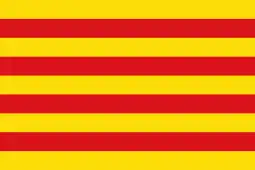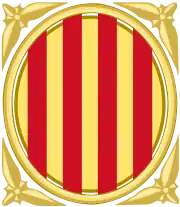Catalonia | |||||||||||
|---|---|---|---|---|---|---|---|---|---|---|---|
| 1931–1939 | |||||||||||
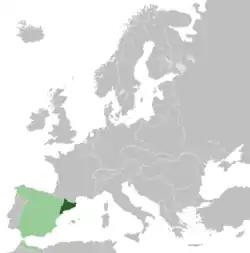 Location of Catalonia (dark green) within the Spanish Republic (light green) and Europe | |||||||||||
| Status | Autonomous region within the Second Spanish Republic | ||||||||||
| Capital | Barcelona | ||||||||||
| Common languages | Catalan, Spanish | ||||||||||
| Demonym(s) | Catalan or Catalonian | ||||||||||
| Government | Generalitat of Catalonia | ||||||||||
| President | |||||||||||
• 1931-1933 | Francesc Macià (first) | ||||||||||
• 1933-1939 | Lluís Companys (last) | ||||||||||
| Legislature | Parliament of Catalonia (1932–1939) | ||||||||||
| Historical era | Interwar period / Spanish Civil War | ||||||||||
| 17 April 1931 | |||||||||||
| 9 September 1932 | |||||||||||
| 6 October 1934 | |||||||||||
| 19 July 1936 | |||||||||||
| 26 January 1939 | |||||||||||
| |||||||||||
| Today part of | Spain ∟Catalonia | ||||||||||
The Autonomous Region of Catalonia (Catalan: Regió autònoma de Catalunya, Spanish: Región autónoma de Cataluña) was established after the grant of self-government to Catalonia during the Second Spanish Republic (1931-1939), becoming an autonomous region within the Spanish Republic. The Generalitat of Catalonia (Catalan: Generalitat de Catalunya) was the institution in which the autonomous government of Catalonia was organized, it was established in order to replace the Catalan Republic proclaimed during the events of the proclamation of the Spanish Republic.
Historians often uses the term "Republican Generalitat" (Catalan: Generalitat Republicana) to refer to this period of the history of Catalonia, in order to distinguish it from the second and current stage of Catalan self-government.
Background
In 1914, the Commonwealth of Catalonia was established, under the presidency of Enric Prat de la Riba (1914-1917) and Josep Puig i Cadafalch (1917-1923), both members of the conservative Regionalist League, then the leading force of Catalan nationalism. It was an administrative institution composed of the provincial councils of Barcelona, Girona, Lleida and Tarragona, but lacked any political or legislative powers.
The Commonwealth was abolished in March 20th, 1925 by decision of the Dictatorship of Miguel Primo de Rivera (1923-1930). After the failed pro-autonomy campaign of 1919,[1] Catalan nationalism became radicalized and adopted more left-wing positions, establishing or reinforcing political parties such as Francesc Macià's pro-independence Estat Català, the Catalan Republican Party, Catalan Action or the Socialist Union of Catalonia, as well as trade unions such as the CADCI or the Unió de Rabassaires. These factors and the shared repression carried out by the Dictatorship facilitated a rapprochement between Catalan nationalism and Spanish Republican forces.
In 1926, Estat Català attempted to liberate Catalonia from the Dictatorship with a volunteer milita and establish an independent Catalan Republic, but the plot was discovered by French police and aborted. Francesc Macià was arrested and judged in France, however, gaining popularity. By the Pact of San Sebastián of August 17, 1930, Republican and Catalan political parties agreed on a global design for the imminent change of regime that included the political autonomy of Catalonia within the projected Republic.
Proclamation of the Republic and the Provisional Generalitat
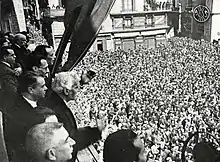
On 12 April 1931, local elections gave a large and unexpected majority in Catalonia (including Barcelona) to the Republican Left of Catalonia (Catalan: Esquerra Republicana de Catalunya, ERC), a party that had been founded three weeks earlier by the union of Macià's pro-independence Estat Català, the Catalan Republican Party, led by Lluís Companys, and L'Opinió group. Francesc Macià proclaimed in Barcelona "the Catalan Republic as a State of the Iberian Federation" on April 14, few hours before the Second Spanish Republic was proclaimed in Madrid.[2] This proclamation and the duality of powers it entailed worried the new Spanish Republic provisional government and, on the 17th, Macià reached an agreement with Spanish ministers Fernando de los Ríos, Marcel·lí Domingo, and Lluís Nicolau d'Olwer, under which the Catalan Republic was renamed with the more ambiguous name of Generalitat de Catalunya, thus recovering the name of one of the most relevant government institutions of the ancient Principality of Catalonia, abolished in 1714.
On April 28, 1931, through a decree of the Spanish Council of Ministers, the Provisional government of the Generalitat was set up, presided by Macià himself and composed by a council or government, an assembly of representatives of the municipalities (the Provisional Deputation of the Generalitat) and the commissioners who, as delegates, were in charge of the services belonging to the suppressed provincial councils of Girona, Tarragona and Lleida. The seat of the Generalitat was established in the Palace of the Plaça de Sant Jaume, Barcelona (which, in turn, was the seat of the original Generalitat). Despite the lack of formal autonomy in this period, the Generalitat showed deployment efforts such as the establishment of the Council of Culture, on June 9, 1931.
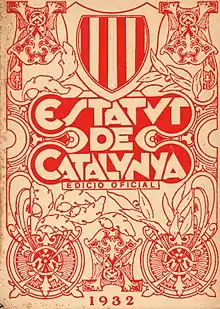
Catalan representatives of the Provisional Deputation prepared a draft bill of the statute of autonomy of Catalonia in Núria (Ripollès, province of Girona) with strong federal features and an extensive list of competences, which was approved in a referendum by the Catalan people on August 2, 1931. The Constitution of the Spanish Republic approved on 9 December 1931 established an unitary state with the possiblity of create autonomous regions, thus differing from the federal Catalan statute proposal. After prolonged and harsh parliamentary debates it was substantially modified and finally passed by the Spanish Cortes on September 9, 1932.
With the Statute approved, on November 20, 1932, the first and sole elections to the Parliament of Catalonia of the Republican era were called. The Republican Left of Catalonia, in coalition with the Socialist Union of Catalonia and other minor Republican parties, won a large majority of seats (67 of 85), while the previously hegemonic Regionalist League came in second place but far behind ERC (17 from 85).[3] which allowed the beggining of construction of the institutions and move from a provisional government to a statutory government with Francesc Macià ratified as President of the Generalitat and Lluís Companys as speaker of Parliament.
Macià Government
Once Francesc Macià was officially appointed, he formed an Executive Council made up exclusively by members of ERC. The most urgent task pending at legislative level was the exhaustive organization of the new institutions. To fullfil that purpose, the Parliament of Catalonia passed its first law, the Statute of Internal Regime of Catalonia (Catalan: Estatut de Règim Interior de Catalunya).
Companys Government
Events of 6 October
The Generalitat during the Civil War
Abolition and exile
See also
| History of Catalonia |
|---|
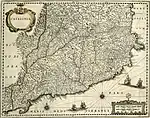 |
| Timeline |
References
- ↑ Batllori, Isidre Molas (1983). "El Projecte d'Estatut d'Autonomia de Catalunya del 1919". Recerques: Història, Economia, Cultura: 69–79. Retrieved 2 February 2019.
- ↑ Roglan 2006, p. 13
- ↑ 1932 Parliament of Catalonia election in Historia Electoral
Sources and bibliography
- Sobrequés i Callicó, Jaume. Catalunya i la Segona República. Edicions d'Ara (Barcelona, 1983) ISBN 84-248-0793-6
- Roglan, Joaquim (2006). 14 d'abril: la Catalunya republicana (1931-1939). Cossetània Edicions. ISBN 8497912039.
- De la Granja, José Luis; Beramendi, Justo; Anguera, Pere (2001). La España de los nacionalismos y las autonomías. Madrid: Síntesis.
- Abello Güell, Teresa (2007). El debat estatutari del 1932 (PDF). Barcelona: Parlament de Catalunya. ISBN 9788439375876.
- Fontana, Josep (2014). La formació d'una identitat. Una història de Catalunya. Ed. Eumo. ISBN 9788497665261.
